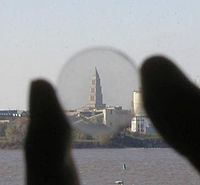
Photo from wikipedia
Abstract This work reports the development of a perfect antireflective coating designed to operate over the 3.7–4.8 µm MWIR region, in order to improve the optics used in thermal detection systems.… Click to show full abstract
Abstract This work reports the development of a perfect antireflective coating designed to operate over the 3.7–4.8 µm MWIR region, in order to improve the optics used in thermal detection systems. A simulated stack with 99.97% average transmittance is designed for a silicon support using an effective refractive index approach. This structure made of two layers is deposited by electron beam evaporation to achieve an optical transmittance as high as 99.21% and a 98.56% average. These performances are similar to that reported for the best MWIR interferential antireflective systems, but rely on a much simpler design. The first layer is fabricated by oblique angle deposition to obtain Ge nanocolumns that are then coated with a dense MgF2 capping film. Because environmental pollution can cause light absorption in the infrared region, different techniques are combined to provide key insights about the nanostructure and the related optical properties: ellipsometry, spectrophotometry and scanning-transmission electron microscopy combined with energy-dispersive X-ray spectrometry. With this approach, essential chemical aspects like oxidation, water adsorption in the Ge layer and intermixing at the Ge/MgF2 interface are evidenced. Advanced models based on effective medium approximation, considering this set of information, are addressed here to gain a better description of the optical response of the surface. In a context of performance optimization of this almost perfect antireflective bilayer, new routes and perspectives to limit or reduce these compositional issues are proposed.
Journal Title: Applied Surface Science
Year Published: 2019
Link to full text (if available)
Share on Social Media: Sign Up to like & get
recommendations!